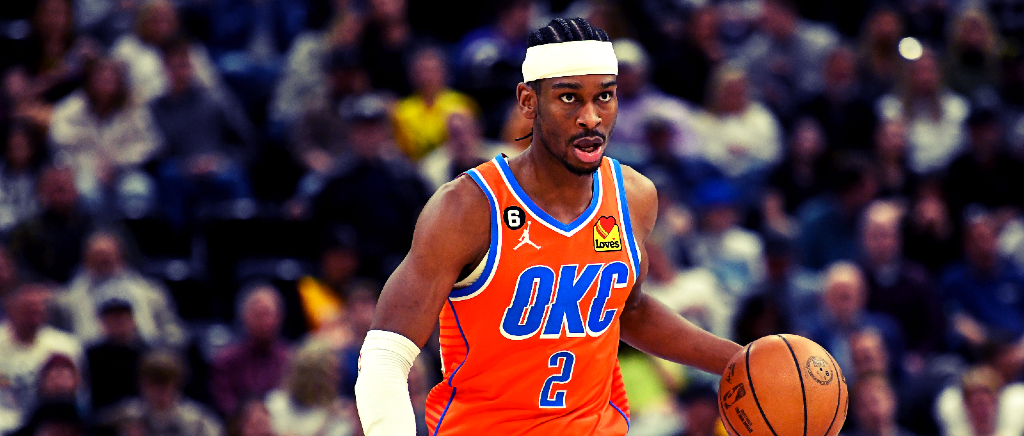
Shai Gilgeous-Alexander told the NBA world before the season that after two tanking seasons, his intentions were to start winning games in Oklahoma City again. It would have only been normal to disregard his confidence as bravado or bluster. But SGA has answered his own call, getting the Thunder to the Play-In Tournament ahead of schedule and producing at an All-NBA level.
The fifth-year star has done it without No. 2 overall pick Chet Holmgren and with the second-youngest roster in league history, made up largely of guys who are on their first NBA contract. Gilgeous-Alexander is a contradiction of hoops history. He has risen to among the best players in the NBA with a throwback style that excels within a modern squad. He was traded suddenly to Oklahoma City despite showing promise with the Los Angeles Clippers, and yet has embraced the Thunder’s rebuild and reconstructed the exuberance associated with Oklahoma City dating back to when the Kevin Durant-led squad made the move to Oklahoma.
Gilgeous-Alexander has cut back on his three-point attempts and upped his free-throw rate during his breakout campaign. With the understanding that individual counting numbers are better than ever, there is little precedent in NBA history for a guard who gets to the line 10-plus times per game, hardly ever turns the ball over, and makes more than half his shots overall. You have to go back at least a decade to find any.
Gilgeous-Alexander is operating this way not by blending into the confines of league trends, but by bucking up against them — he’s behind only Luka Doncic in terms of frequency and efficiency on isolations. With 1.06 points per possession in isolation, SGA is more efficient than superstars like Jayson Tatum, Trae Young, and even Kevin Durant when he goes one-on-one.
As a driver, he’s is even better. SGA is leading the NBA in drives per game for the third straight season, and scoring 17.1 points per game off those drives — the best mark in the NBA by almost three points. He also possesses the lowest turnover rate on drives of any of the most prolific downhill scorers in the league.
This is possible in large part because of how Oklahoma City has been built around him, as the team emphasizes ball movement and spacing. They force turnovers on defense and are elite at turning steals into offense on the other end. They get to the line and are fairly adept at getting offensive rebounds. Yet the Thunder aren’t even in the top half of the league in three-point frequency — their spacing is a product of brute force and the quick, crisp way they move the ball. SGA can get one of the team’s many wings the ball and watch them find an opening inside and power through the opponent.
When teams sell out to guard Gilgeous-Alexander’s drives, packing the paint and daring younger scorers like Josh Giddey or Jalen Williams to shoot, SGA has mastered the dance of scoring in no man’s land. He draws fouls on more than 20 percent of Thunder possessions, but his style is far from cheap, as he has made 46 percent of his midrange jumpers this season and is shooting a career-high 64 percent at the rim. In an era of pull-up threes and pick-and-rolls, SGA uses the almost postmodern, positionless roster the Thunder have assembled to free himself up to play basketball like it’s 2003 again.
At the same time, Gilgeous-Alexander is the face of a budding Thunder team that would remind any hoops fan of 2009. SGA was a casualty of the NBA’s megatrade era, in which roster-building became less about planning for free agency and more about nailing huge transactions. SGA came to Oklahoma City alongside a number of first round picks and swaps in return for Paul George, the golden ticket for the Clippers to woo Kawhi Leonard in free agency.
The past two seasons, the Thunder have shut him down early to rehab physical issues. It’s hard to say from afar what is going on with a player’s body, but considering Oklahoma City’s concerted tank job in recent seasons and accumulation of young players and draft picks, it at least seems that maximizing SGA’s availability wasn’t in the larger interest of the front office. He took it all in stride, never publicly complaining or disagreeing, then came back last fall very clearly ready to turn the page and start winning again.
So no, Gilgeous-Alexander didn’t choose this. Like Brandon Ingram, Mikal Bridges, and Lauri Markkanen, the new face of the Thunder arrived as a domino that fell from the departure of a franchise centerpiece. He’s has made that departure sting significantly less, become a leader for the Thunder, and has perhaps already surpassed George’s tenure in OKC.
In this second chapter of NBA megatrade life, how the trading team fares can be determined by lottery balls and draft picks, sure, but also in large part by how the blue chipper they got back performs on the court. Gilgeous-Alexander is the product of this modern trend in the league, yet has transformed the Thunder back into something wholly recognizable.
It’s rare for a player, especially one so young, to make an All-NBA team on a squad hovering around .500. Typically, voters and NBA fans are in unison casting down such players as having empty stats or needing to further prove something before they are rewarded. Perhaps as an emblem of our collective appreciation of his unusual circumstances and unique talents, SGA looks like a lock for All-NBA honors. He has blown past the usual doubts, as the Thunder’s stature as the 10-seed in the West is on the backs of his nightly Herculean performances. He has become a franchise icon for the future, today’s star, and yesterday’s hooper.
